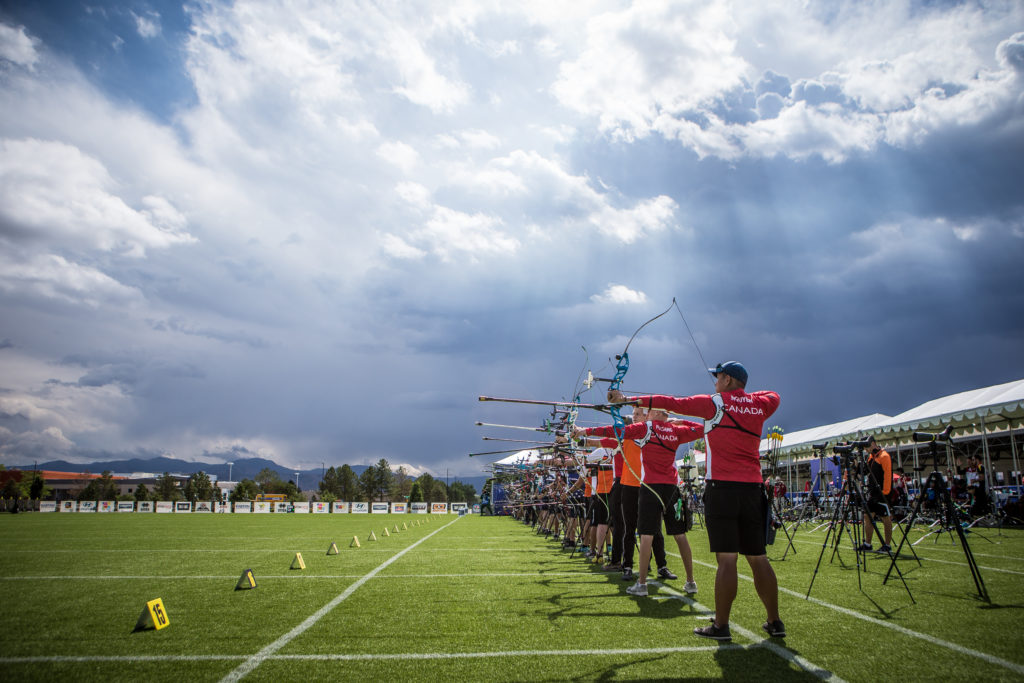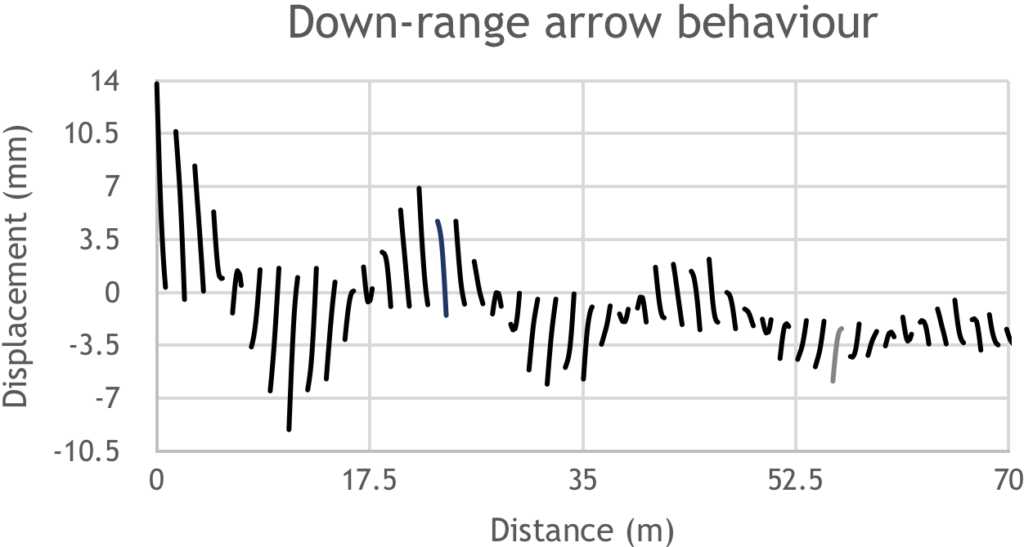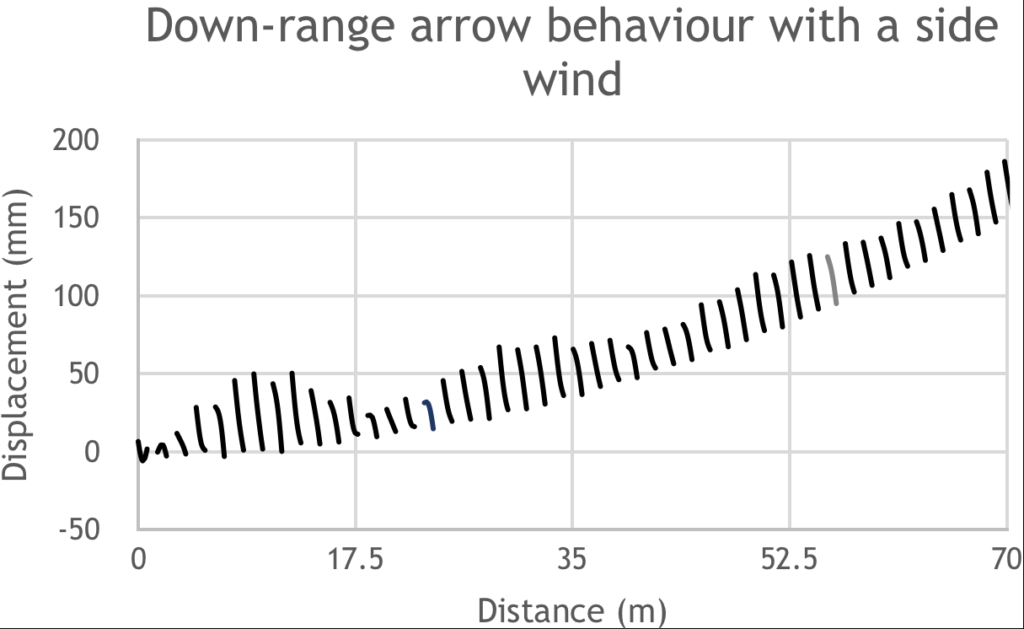Dr. James Park explains just what happens on the way to the target.

Arrows do rather a lot in the few moments they spend in the air. They flex vertically and laterally, rotate about their centre of mass in both planes (pitch and yaw) and about their longitudinal axis (roll).
Ideally, we would like very little pitch and yaw – we would like to see our arrows fly straight. They will inevitably flex due to the high forces on them during the bow’s power stroke, and we need them to do so in order to have them clear the bow.
We would also like them to roll in order to average out small inconsistencies in their construction, and we do that by having the fletches set at an angle to the shaft’s longitudinal axis. We can generally consider an arrow to be incompressible longitudinally but flexible laterally.
Virtually all arrows will be aerodynamically stable since their aerodynamic centre is behind their centre of mass. That is, the aerodynamic forces on the arrow are trying to keep the point in front of the nock. Even without fletches this is usually the case due to the high proportion of the arrow’s mass taken by the point. An unfletched arrow may fly poorly but even so it will still not tumble.
Arrows usually flex in two modes. The first mode has two nodes, one about 50mm from the point and the other about 150mm from the nock. In the first mode the arrow flexes about 80-90 times per second.
That is, for a compound bow about once per metre of travel. In the second mode there are three nodes and the flex rate is usually about 210-220 times per second. Usually the magnitude of the second mode is small compared to the first mode.
There are also higher modes of flexing but their magnitudes will usually be insignificant. When we watch high frame rate video of arrows flexing we sometimes see an ‘S’ shape – that is showing the presence of the second mode and well as the first mode.
As noted, we need the arrow flex. In selecting the optimal arrows for our bow we are matching the rate of flex with how long it takes the arrow to get out of our bow. This is an important choice.
An important function of the fletching is to get the arrow to line up with the direction of the resultant air flow. That is, the fletching is used to minimise oscillation in pitch and yaw (or in archery terms, to minimise porpoising and fishtailing).
Without wind we want the arrow to fly stably and aligned with its direction of travel. When there is wind we want the arrow to fly stably but now it will fly at an angle to its direction of travel (as the airflow it sees will be at an angle).
Contrary to a popular misunderstanding, it is not the aerodynamic drag of the fletching that does most to help align the arrow with the airflow. It is primarily the aerodynamic lift. Drag is the aerodynamic force aligned with the airflow.
Lift is the aerodynamic force perpendicular to the airflow (and note that ‘lift’ does not mean ‘up’ – it could be at any angle, even ‘down’). While the fletches certainly have both drag and lift, the lever arm in relation to the arrow’s centre of mass is a lot longer for the lift than for the drag, so the lift does most of the work.
If the arrow is not currently aligned with the airflow (for example, as it leaves the bow) the aerodynamic forces act to move it closer to alignment. Usually it will overshoot and then need to move back in the other direction – engineers describe this behaviour as ‘under damped’.
Blowing in the wind
To show how the arrow aligns with the airflow: in the top diagram, the arrow is travelling to the right, in no wind but with an initial angle of attack and a small amount of flex.
It is sampled every 20 msec. The second shows the arrow aligning with the resultant airflow in wind. You can see that the drift in wind at 70m is a lot greater than at 50m. Essentially, most of the deviation happens in the last 20m of the range.


Typically, the arrow will travel about 20m for each cycle of this oscillation, and this is the behaviour you see if you watch along the arrow’s path from behind.
Nevertheless, the drag from the fletches is important in relation to the arrow’s lateral movement in wind. Interestingly, it is not just the drag from the airflow over the fletch surface that matters but also the fletch profile drag – from its edges. That means that for a given fletch area we will do best by selecting a low profile fletch – longer rather than higher for a given area.
The other important function of the fletching is to spin the arrow – the aerodynamic roll. I see many archers placing their fletches directly along the arrow shaft, with no fletch angle. This is giving away points, since arrows group better if we spin then.
The lift from the fletches depend on their angle to the airflow. This means that once the arrow is spinning at the right rate to have the resultant airflow directly along the fletch there is no lift and that will be the stable rotation rate. Typically, for an X10 arrow shaft and a fletch angle of about 1 degree the arrow will rotate once for about every 2-3 metres of travel (which is sufficient).
While the arrow is attached to the string it of course cannot rotate. The rotation starts when the nock leaves the string. After about 10m of travel the spin rate will typically be reasonably close to the stable rate.
Note that the time it takes for the rear of the arrow to pass the riser after the arrow leaves the string is very short, so the angle of the fletches as they pass the riser is very close to the same as when the arrow is attached to the string. Once at the stable rotation rate the drag is the same as if there was no fletch angle.
It takes a small amount of energy to get the arrow spinning and that energy comes from a (very) small decrease in the arrow’s speed. At most it is only a few ft/sec so practically it is nothing, particularly when considering the decrease in group size from spinning the arrow.


In your experience, have you seen any evidence of roll-yaw coupling during the arrow flight? I assume that the roll rate is too low to couple with the bending frequency, but that too may couple as well.
Also, I cannot easily tell from the plots, but in the figures is the displacement shown the amount that the tail is moved off the flight path? Thanks, Darrel